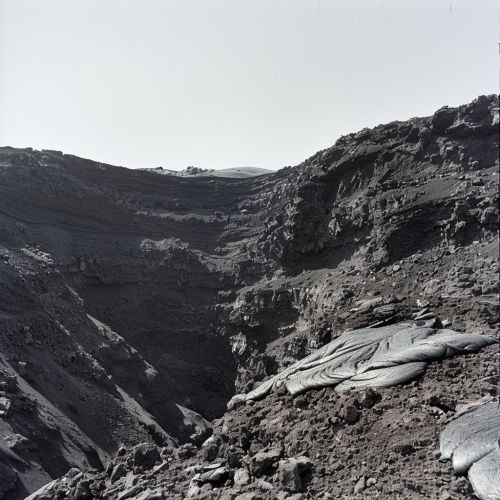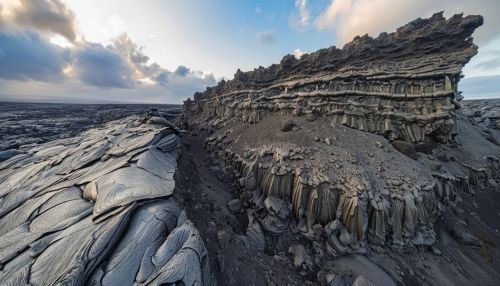Lava Dome: Difference between revisions
(Created page with "== Introduction == A '''lava dome''' is a roughly circular mound-shaped protrusion resulting from the slow extrusion of viscous lava from a volcano. Lava domes are formed by the accumulation of highly viscous lava that is too thick to flow far from the vent, resulting in a steep-sided, dome-shaped structure. These geological formations are significant in understanding volcanic processes and hazards. == Formation and Characteristics == Lava domes are typically composed...") |
No edit summary |
||
| Line 7: | Line 7: | ||
Lava domes are typically composed of [[andesite]], [[dacite]], or [[rhyolite]] lava, which are high in silica content, making the lava highly viscous. The formation of a lava dome begins when magma rises to the surface and extrudes slowly, piling up over the vent. The viscosity of the lava prevents it from flowing away, leading to the characteristic dome shape. | Lava domes are typically composed of [[andesite]], [[dacite]], or [[rhyolite]] lava, which are high in silica content, making the lava highly viscous. The formation of a lava dome begins when magma rises to the surface and extrudes slowly, piling up over the vent. The viscosity of the lava prevents it from flowing away, leading to the characteristic dome shape. | ||
[[Image:Detail-91301.jpg|thumb|center|Lava dome in a volcanic landscape, with steep sides and a rough, blocky surface.|class=only_on_mobile]] | |||
[[Image:Detail-91302.jpg|thumb|center|Lava dome in a volcanic landscape, with steep sides and a rough, blocky surface.|class=only_on_desktop]] | |||
The surface of a lava dome is often rough and blocky due to the breaking and cooling of the lava as it extrudes. This surface can be highly fractured and unstable, posing significant hazards such as rockfalls and pyroclastic flows. The internal structure of a lava dome is typically complex, with a core of solidified lava surrounded by a shell of fragmented and brecciated material. | The surface of a lava dome is often rough and blocky due to the breaking and cooling of the lava as it extrudes. This surface can be highly fractured and unstable, posing significant hazards such as rockfalls and pyroclastic flows. The internal structure of a lava dome is typically complex, with a core of solidified lava surrounded by a shell of fragmented and brecciated material. | ||
Latest revision as of 22:01, 21 June 2024
Introduction
A lava dome is a roughly circular mound-shaped protrusion resulting from the slow extrusion of viscous lava from a volcano. Lava domes are formed by the accumulation of highly viscous lava that is too thick to flow far from the vent, resulting in a steep-sided, dome-shaped structure. These geological formations are significant in understanding volcanic processes and hazards.
Formation and Characteristics
Lava domes are typically composed of andesite, dacite, or rhyolite lava, which are high in silica content, making the lava highly viscous. The formation of a lava dome begins when magma rises to the surface and extrudes slowly, piling up over the vent. The viscosity of the lava prevents it from flowing away, leading to the characteristic dome shape.


The surface of a lava dome is often rough and blocky due to the breaking and cooling of the lava as it extrudes. This surface can be highly fractured and unstable, posing significant hazards such as rockfalls and pyroclastic flows. The internal structure of a lava dome is typically complex, with a core of solidified lava surrounded by a shell of fragmented and brecciated material.
Types of Lava Domes
Lava domes can be classified into several types based on their morphology and eruption style:
Endogenous Domes
Endogenous domes grow from within as new lava is injected into the interior of the dome, causing it to expand. This type of growth can lead to the formation of large, complex structures with multiple lobes and spines.
Exogenous Domes
Exogenous domes grow by the extrusion of lava onto the surface of the dome. This type of growth results in a more uniform and symmetrical structure, with lava flowing outward from the vent.
Pelean Domes
Named after the 1902 eruption of Mount Pelée, Pelean domes are characterized by the extrusion of highly viscous lava that forms steep-sided spines or coulees. These domes are often associated with explosive eruptions and pyroclastic flows.
Coulées
Coulées are a type of lava dome that forms when highly viscous lava flows a short distance from the vent before solidifying. These structures are typically elongated and have steep sides.
Eruption Dynamics
The eruption dynamics of lava domes are influenced by the viscosity of the magma, the rate of extrusion, and the presence of volatiles. Lava dome eruptions can be effusive, with lava slowly oozing out of the vent, or explosive, with the sudden release of gas and pyroclastic material.
Effusive Eruptions
Effusive eruptions involve the steady extrusion of lava, leading to the gradual growth of the dome. These eruptions are typically less hazardous but can still pose risks due to the instability of the dome surface.
Explosive Eruptions
Explosive eruptions occur when gas pressure builds up within the magma, leading to a sudden release of energy. This can result in the fragmentation of the dome and the generation of pyroclastic flows, which are fast-moving currents of hot gas and volcanic material.
Hazards Associated with Lava Domes
Lava domes pose several hazards to nearby populations and infrastructure:
Pyroclastic Flows
Pyroclastic flows are one of the most dangerous hazards associated with lava domes. These flows can travel at high speeds and reach temperatures of up to 1,000 degrees Celsius, destroying everything in their path.
Rockfalls and Landslides
The steep and unstable surfaces of lava domes are prone to rockfalls and landslides. These events can occur without warning and pose significant risks to areas surrounding the dome.
Volcanic Gas Emissions
Lava domes can emit volcanic gases such as sulfur dioxide, carbon dioxide, and hydrogen sulfide. These gases can be harmful to human health and contribute to environmental degradation.
Monitoring and Mitigation
Monitoring lava domes is crucial for assessing volcanic hazards and mitigating risks. Techniques used to monitor lava domes include:
Seismic Monitoring
Seismic monitoring involves the use of seismometers to detect earthquakes and volcanic tremors associated with magma movement. This data can provide early warning of potential eruptions.
Ground Deformation
Ground deformation measurements, using techniques such as GPS and InSAR, can detect changes in the shape of the volcano, indicating magma intrusion and dome growth.
Gas Emissions
Monitoring volcanic gas emissions can provide insights into the state of the magma and the likelihood of an eruption. Instruments such as DOAS and FTIR are commonly used for this purpose.
Visual Observations
Visual observations, including satellite imagery and aerial surveys, are used to monitor changes in the dome's morphology and surface activity.
Case Studies
Several notable lava domes have been studied extensively, providing valuable insights into their formation and behavior:
Mount St. Helens, USA
The 1980 eruption of Mount St. Helens resulted in the formation of a lava dome within the crater. This dome has been the subject of numerous studies, providing insights into dome growth and volcanic hazards.
Soufrière Hills, Montserrat
The ongoing eruption of Soufrière Hills volcano has produced a large lava dome, which has been closely monitored since 1995. This case study highlights the importance of continuous monitoring and hazard assessment.
Mount Unzen, Japan
The 1991-1995 eruption of Mount Unzen produced a lava dome that generated deadly pyroclastic flows. This event underscored the dangers posed by lava domes and the need for effective risk mitigation strategies.
Conclusion
Lava domes are complex and dynamic volcanic structures that pose significant hazards. Understanding their formation, eruption dynamics, and associated risks is crucial for effective monitoring and mitigation. Ongoing research and technological advancements continue to improve our ability to predict and respond to volcanic activity involving lava domes.
